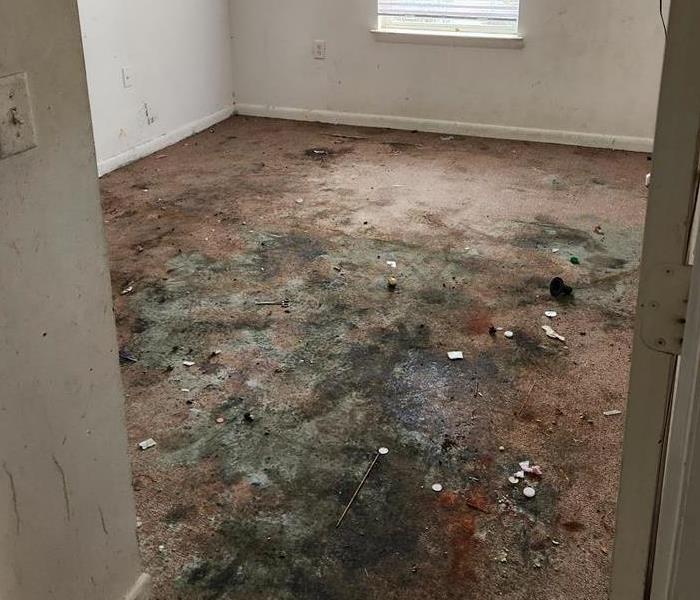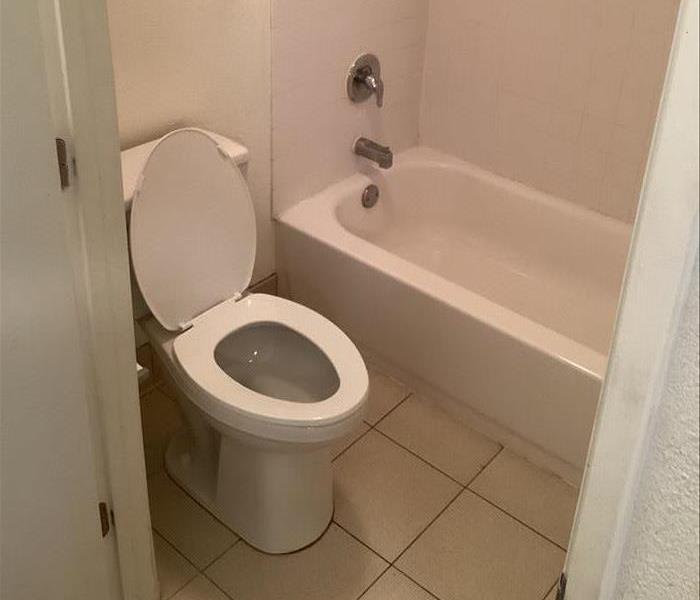Recent Posts
Foundation Cracks and Water Infiltration: Causes and Fixes
3/12/2025 (Permalink)
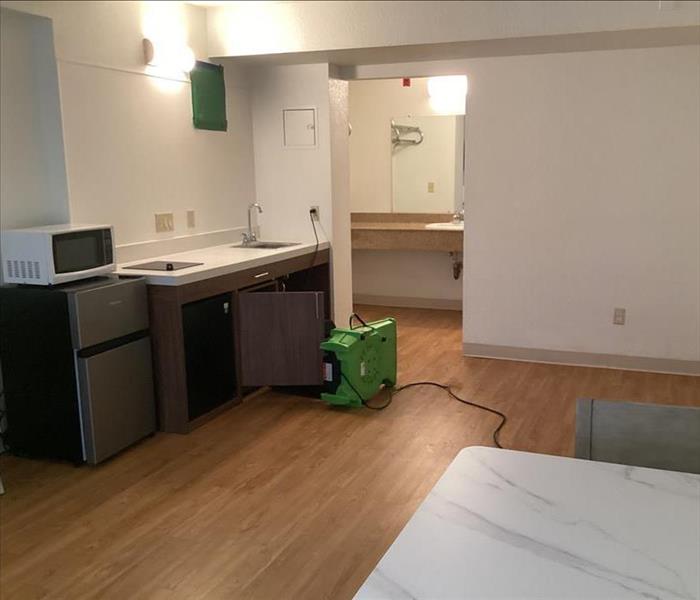 A strong foundation is essential for any home or building in California, but foundation cracks and water infiltration can compromise its stability.
A strong foundation is essential for any home or building in California, but foundation cracks and water infiltration can compromise its stability.
A strong foundation is essential for any home or building in California, but foundation cracks and water infiltration can compromise its stability. When water seeps into your foundation, it can lead to costly repairs and structural damage. Understanding the causes of foundation cracks and how to fix them is crucial for maintaining the integrity of your property.
In this guide, we’ll explore the common causes of foundation cracks, the risks of water infiltration, and expert solutions to protect your home.
Common Causes of Foundation Cracks
Foundation cracks can occur for various reasons, but identifying the root cause is the first step in preventing water infiltration. Here are some of the most common causes:
1. Soil Movement and Settlement
- Over time, soil naturally shifts due to changes in moisture levels, causing the foundation to settle unevenly.
- Expansive clay soils swell when wet and shrink when dry, creating pressure on foundation walls.
2. Poor Drainage Around the Property
- Inadequate drainage can cause water to pool around the foundation, leading to hydrostatic pressure and cracks.
- Clogged gutters or improper downspout placement can contribute to excess moisture.
3. Freeze-Thaw Cycles
- In colder climates, water in the soil can freeze and expand, putting pressure on the foundation.
- This repeated cycle of freezing and thawing weakens concrete over time, leading to cracks.
4. Poor Construction and Materials
- Substandard concrete mixtures or improper curing can result in weak foundations prone to cracking.
- Lack of reinforcement, such as steel bars, can make foundations more susceptible to movement.
5. Tree Roots and Vegetation
- Large tree roots can extract moisture from the soil, causing it to shrink and creating foundation instability.
- Roots can also penetrate foundation walls, worsening existing cracks.
How Water Infiltrates Foundation Cracks
Once foundation cracks form, they provide a direct pathway for water to enter your home. Water infiltration can lead to:
- Basement flooding and property damage.
- Increased humidity, which can weaken building materials.
- Deterioration of concrete and further foundation instability.
- Damage to flooring, drywall, and electrical systems.
Fixing Foundation Cracks and Preventing Water Infiltration
Fortunately, foundation cracks and water infiltration can be addressed with the right solutions. Here’s how to fix and prevent these issues:
1. Seal Foundation Cracks
- Use epoxy injections or urethane sealants to fill minor cracks and prevent water from seeping in.
- For larger structural cracks, professional reinforcement with carbon fiber strips or steel braces may be necessary.
2. Improve Drainage Around the Property
- Install or clean gutters and downspouts to direct water away from the foundation.
- Extend downspouts at least 5-10 feet away from the home.
- Ensure the ground slopes away from the foundation to prevent pooling water.
3. Waterproof the Foundation
- Apply exterior waterproof coatings to the foundation walls.
- Install a drainage system, such as a French drain, to redirect water away from the home.
- Use interior waterproofing solutions, such as sump pumps and drainage tiles, for additional protection.
4. Address Soil and Landscaping Issues
- Avoid planting trees too close to the foundation to prevent root intrusion.
- Use gravel or crushed stone instead of dense clay near the foundation to improve drainage.
- Install a foundation skirt to reduce moisture fluctuations in the soil.
5. Schedule Regular Inspections
- Have a professional inspect your foundation at least once a year to catch issues early.
- Monitor for signs of water damage, such as musty odors, damp walls, or pooling water in basements or crawl spaces.
FAQs About Foundation Cracks and Water Infiltration
How do I know if a foundation crack is serious?
Hairline cracks are usually minor and can be sealed easily. However, wide cracks, horizontal cracks, or those with noticeable movement indicate a more serious structural issue requiring professional repair.
Can I fix the foundation cracks myself?
Small cracks can often be sealed with epoxy or polyurethane sealants. However, larger or structural cracks should be evaluated and repaired by a professional.
Does home insurance cover foundation cracks and water infiltration?
Insurance coverage depends on the cause of the damage. Sudden and accidental water damage, such as burst pipes, may be covered, but gradual foundation deterioration is typically excluded.
How much does it cost to repair foundation cracks?
The cost varies based on the severity of the damage. Minor crack repairs can cost a few hundred dollars, while extensive structural repairs may range from several thousand to tens of thousands of dollars.
Foundation cracks and water infiltration can pose serious risks to the integrity of your home, but with the right preventative measures and repairs, you can protect your property from costly damage. Regular inspections, proper drainage, and professional foundation repair services are key to maintaining a strong foundation.
If you’re dealing with foundation cracks or water infiltration, SERVPRO® is ready to help with expert water damage restoration and structural repair solutions. Contact us today for a professional assessment and lasting protection!
How to Properly Clean and Maintain Your Outside Dryer Vent
12/6/2024 (Permalink)
Cleaning your outside dryer vent is a crucial maintenance task that helps improve the efficiency of your dryer, reduces energy consumption, and, most importantly, prevents potential fire hazards. Over time, lint and debris can accumulate in the vent, restricting airflow and causing the dryer to overheat. If left unchecked, this buildup could lead to a fire. According to the U.S. Fire Administration, dryer fires account for thousands of fires annually, and failure to clean the dryer is a leading cause. Here’s a guide to cleaning your outside dryer vent effectively.
Step 1: Gather the Necessary Tools
Before you begin, gather all the tools and supplies you will need. These include:
- A vacuum with a hose attachment
- A vent cleaning brush or dryer vent cleaning kit
- A screwdriver (if your vent cover is screwed in place)
- A ladder (if the vent is high off the ground)
- A mask and gloves (optional, but recommended for handling lint)
Step 2: Disconnect the Dryer
Before cleaning the vent, it’s important to disconnect your dryer from the power source. If you have a gas dryer, shut off the gas valve as well. Pull the dryer away from the wall to access the vent pipe that connects to the outside exhaust vent.
Step 3: Clean the Interior Duct
While this guide focuses on the exterior vent, it’s a good idea to clean the dryer duct inside your home first. Use a vacuum to clean the lint from the vent pipe that runs from the back of your dryer to the outside. A vent cleaning brush can also help dislodge any lint that’s stuck to the walls of the duct.
Step 4: Locate and Inspect the Outside Dryer Vent
Go outside and locate the vent that leads from your dryer to the exterior of your home. This is typically a small, square vent located on an outside wall. Before cleaning, inspect the vent for any visible lint or debris buildup. If you notice any bird nests or other obstructions, remove them carefully.
Step 5: Remove the Vent Cover
Most outside dryer vents have a cover to prevent animals, insects, or debris from entering the vent. If the vent cover is secured with screws, use your screwdriver to remove them. Some covers may simply snap off.
Step 6: Clean the Outside Vent
With the cover removed, use your vacuum hose to remove as much lint as possible from the vent. Next, take your dryer vent brush or cleaning kit and push it into the vent, rotating it as you go. This will help dislodge any lint buildup that’s stuck to the sides of the vent.
Step 7: Reassemble and Test
Once you’ve cleaned the vent thoroughly, reattach the vent cover. Go back inside and reconnect your dryer to the power source or turn the gas valve back on. Run your dryer for a few minutes to ensure proper airflow through the vent.
Regularly cleaning your outside dryer vent can significantly reduce the risk of dryer fires and keep your appliance running efficiently. Ideally, you should clean your vent every six months, or more frequently if you use your dryer heavily. If you ever notice that your clothes are taking longer to dry, or if you feel heat buildup around your dryer, it may be time to check your vent for blockages.
By following these simple steps, you can help ensure your dryer operates safely and efficiently. However, if you encounter a difficult-to-clean or severely clogged vent, it may be best to contact a professional cleaning service like SERVPRO®, who can ensure the job is done thoroughly and safely.
Refrigerant vs. Desiccant: Key Differences in Climate Control Solutions
10/16/2024 (Permalink)
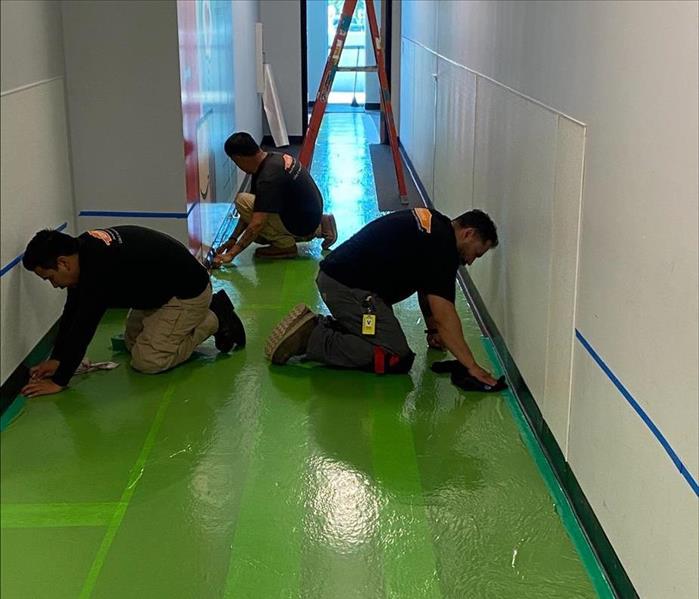 This blog delves into the critical distinctions between refrigerant and desiccant systems, drawing on expert insights.
This blog delves into the critical distinctions between refrigerant and desiccant systems, drawing on expert insights.
When it comes to maintaining optimal humidity and temperature conditions in commercial or industrial spaces, businesses often face the choice between refrigerant and desiccant dehumidification systems. Both methods are effective for different applications, but understanding the key differences can help in making an informed decision. This blog delves into the critical distinctions between refrigerant and desiccant systems, drawing on expert insights to help you determine which is best suited for your needs.
What Is a Refrigerant Dehumidifier?
Refrigerant dehumidifiers, also known as compressor dehumidifiers, operate on the same principle as air conditioners. They work by drawing moist air over a cooled coil, which causes the moisture in the air to condense into water. The collected water is then drained away, and the drier air is released back into the space.
This type of dehumidifier is particularly effective in warm, humid environments. Because the cooling coil needs to be significantly colder than the air temperature, refrigerant dehumidifiers work best in environments with temperatures above 65°F (18°C). They are widely used in residential settings and for general humidity control in commercial spaces.
Key Benefits of Refrigerant Dehumidifiers:
- Cost-effective for general humidity control
- Best suited for warm environments
- Relatively low maintenance
- High capacity for moisture removal in ideal conditions
One of the notable strengths of refrigerant dehumidifiers is their efficiency in warm climates. However, their effectiveness drops in cooler environments where moisture doesn't condense as easily.
What Is a Desiccant Dehumidifier?
Desiccant dehumidifiers use a completely different method to remove moisture from the air. Instead of cooling the air to condense water, desiccant systems rely on hygroscopic materials like silica gel to absorb moisture. The moisture-laden air passes through a rotor filled with desiccant material, which traps water molecules. The collected moisture is then heated and expelled through an exhaust system.
This makes desiccant dehumidifiers highly effective in low-temperature environments where refrigerant systems struggle. They are often used in industrial applications, cold storage, and spaces that require precise humidity control, such as museums and pharmaceutical manufacturing facilities.
Key Benefits of Desiccant Dehumidifiers:
- Effective in cold and low-temperature environments
- Ideal for applications requiring very low humidity levels
- Can operate in sub-zero conditions
- Durable with a long lifespan
One significant advantage of desiccant dehumidifiers is their ability to maintain performance in colder settings. Unlike refrigerant models, they are not dependent on temperature differentials to extract moisture, making them more versatile across a broader range of environmental conditions.
Comparing Refrigerant and Desiccant Dehumidifiers
While both types of dehumidifiers serve the same basic function—removing moisture from the air—the methods they use make them suited to different applications. Here’s a breakdown of their key differences:
- Operating Principle: Refrigerant dehumidifiers use condensation, while desiccant dehumidifiers absorb moisture through a hygroscopic material.
- Best Use Cases: Refrigerant systems excel in warm environments, whereas desiccant systems are better for cold or low-humidity applications.
- Energy Efficiency: Refrigerant dehumidifiers are generally more energy-efficient in warm climates, but desiccant systems can be more efficient in colder environments.
- Maintenance Needs: Refrigerant systems require regular cleaning of coils and drainage, while desiccant systems need periodic replacement of the desiccant material.
One statistic highlights the importance of selecting the right dehumidification method: The global demand for desiccant dehumidifiers is projected to grow at a compound annual growth rate (CAGR) of 7.5% from 2020 to 2027, driven by increasing adoption in industrial sectors.
Choosing the Right System for Your Needs
Selecting between a refrigerant and desiccant dehumidifier ultimately comes down to your specific needs:
- Climate: For warmer climates, refrigerant systems are typically more cost-effective and efficient.
- Application: For cold storage or industrial applications requiring low humidity, desiccant systems are the better option.
- Energy Considerations: Consider the long-term energy costs based on the environmental conditions in which the system will operate.
Conclusion
Understanding the key differences between refrigerant and desiccant dehumidifiers can help you make a more informed decision for your specific humidity control needs. While refrigerant dehumidifiers are ideal for general residential or commercial use in warmer climates, desiccant dehumidifiers offer superior performance in colder environments and specialized industrial applications. By weighing the pros and cons of each system, you can choose the most suitable dehumidification solution for your space.
Safeguarding Your Home: How Mold Impacts Structural Integrity and Solutions for Prevention
10/16/2024 (Permalink)
When left untreated, mold can cause long-term damage to various parts of your property, weakening the materials that make up the framework of your home. Understanding how mold can compromise structural elements and what steps to take can help protect your investment. In this blog, we'll discuss the risks mold poses to your home's structure and how professional services, like SERVPRO®, can help restore and safeguard your property.
How Does Mold Affect Your Home's Structure?
Mold thrives in damp, dark environments, making areas like basements, attics, and behind walls particularly vulnerable. While mold spores are naturally present in the air, they require moisture to grow. Once mold establishes itself, it can begin to feed on organic materials such as wood, drywall, and insulation—key components of your home’s structure.
- Wood Decay: Mold can break down wood fibers, which weakens structural supports like beams, floorboards, and wall studs. Over time, this can lead to warping, cracking, or even collapsing of these critical elements.
- Drywall Damage: Mold can spread across drywall, causing it to become brittle and lose its structural integrity. Damaged drywall may need to be completely replaced if mold has compromised it beyond repair.
- Insulation Issues: Mold can infiltrate insulation materials like fiberglass or foam. Once mold grows in these materials, their effectiveness is compromised, leading to reduced energy efficiency in your home. This can also increase the cost of repairs, as insulation may need to be removed and replaced.
- Foundation and Floor Damage: Mold that grows in basements or crawl spaces can also damage concrete foundations or floor joists. While concrete is less prone to mold damage than wood, the moisture that allows mold to grow can also contribute to cracks and deterioration in your foundation.
Signs That Mold May Be Affecting Your Home's Structure
One of the tricky aspects of mold damage is that it often goes unnoticed until the problem has worsened. Mold can thrive in hidden places, behind walls, under floors, or in poorly ventilated spaces like attics and basements. Keep an eye out for these signs:
- Visible Mold Growth: If you see mold growing on walls, floors, or ceilings, this is a strong indication of a larger issue.
- Musty Odors: Mold produces a distinct, musty smell that often signals hidden growth.
- Discoloration and Staining: Water stains or discoloration on walls or ceilings can indicate moisture problems that are ideal conditions for mold growth.
- Warped or Buckling Floors/Walls: If floors or walls appear to warp or buckle, this can suggest moisture and mold issues behind the surface.
SERVPRO’s Role in Mold Remediation and Structural Protection
Mold remediation isn’t just about removing surface-level growth; it requires addressing the root cause of the moisture and thoroughly treating affected areas to prevent recurrence. SERVPRO specializes in mold remediation services that go beyond cleaning visible mold. With advanced tools and techniques, SERVPRO can assess the extent of the damage, remove contaminated materials, and dry the affected areas to halt mold growth.
SERVPRO also helps restore the structural integrity of your home by removing damaged building materials like drywall and insulation, replacing them with fresh materials. Additionally, professionals will advise on moisture control measures, such as improved ventilation or fixing leaks, to prevent future mold growth.
Protecting Your Home from Structural Mold Damage
The best way to prevent mold from damaging your home’s structure is to stay vigilant and address any moisture issues immediately. Whether it’s a slow leak, poor ventilation, or flooding, taking quick action can prevent mold from taking hold.
If you suspect mold or have already noticed damage, contact SERVPRO of South Redlands/Yucaipa/North Riverside City/Big Bear/Lake Arrowhead/NE Rancho Cucamonga for expert mold remediation and restoration services.
By addressing mold early and seeking professional help, you can preserve the strength and stability of your home for years to come.
Pets and Mold: Protecting Your Furry Friend
7/17/2024 (Permalink)
As pet owners, we know how important it is to keep our furry friends safe and comfortable. One often overlooked threat to their well-being is mold. Mold can grow in any home and thrive in damp, humid environments, posing a risk to our pets. At SERVPRO®, we understand the importance of maintaining a mold-free home, not just for your family but also for your pets. Here are some tips and insights on how to protect your furry friends from mold.
Understanding Mold Growth
Mold spores are everywhere, but they only become a problem when they find a suitable environment to grow. Moisture is the key ingredient for mold growth. Common places where mold can develop include basements, bathrooms, kitchens, and areas around leaky windows or roofs. Mold can also thrive in pet areas, such as near water bowls, in aquariums, or in spaces where pets might have accidents.
Preventing Mold in Pet Areas
- Keep Pet Areas Dry: Ensure that any areas where your pets spend time are kept dry and well-ventilated. This includes spaces where they eat, sleep, and play. Use a dehumidifier in damp areas and fix any leaks promptly to prevent moisture buildup.
- Regular Cleaning: Regularly clean your pet’s bedding, toys, and feeding areas. Use washable materials for pet beds and blankets, and wash them frequently in hot water to kill any mold spores.
- Control Humidity: Keep indoor humidity levels below 60% by using air conditioners or dehumidifiers. You can also use exhaust fans in bathrooms and kitchens to reduce moisture.
- Aquarium Care: If you have an aquarium, ensure it is properly maintained. Regularly clean the tank and ensure it has a good filtration system to prevent mold growth.
Detecting Mold Early
It's essential to detect mold early to prevent it from spreading. Look for visible signs of mold, such as black or green spots on walls, ceilings, or floors. Mold can also have a musty odor, which can be a telltale sign of its presence. If you suspect mold, it’s crucial to address it immediately.
Professional Mold Remediation
While small mold issues can sometimes be handled with proper cleaning, larger mold problems require professional intervention. SERVPRO offers expert mold remediation services to ensure your home is thoroughly cleaned and safe for both your family and pets. Our team uses advanced equipment and techniques to detect and eliminate mold, ensuring it doesn’t return.
Creating a Mold-Free Environment
Maintaining a mold-free environment is a continuous process. Regular home inspections, proper ventilation, and immediate attention to moisture issues are key steps in preventing mold growth. By taking these proactive measures, you can protect your pets from the risks associated with mold and ensure they remain happy and healthy in a safe home environment.
Your pets rely on you for their safety and comfort. By understanding the risks of mold and taking steps to prevent its growth, you can create a healthier living space for your furry friends. Remember, if you ever encounter a mold problem that's too big to handle on your own, SERVPRO is here to help with professional mold remediation services. Together, we can ensure a mold-free home for you and your pets.
The Importance of Prompt Water Damage Restoration
6/11/2024 (Permalink)
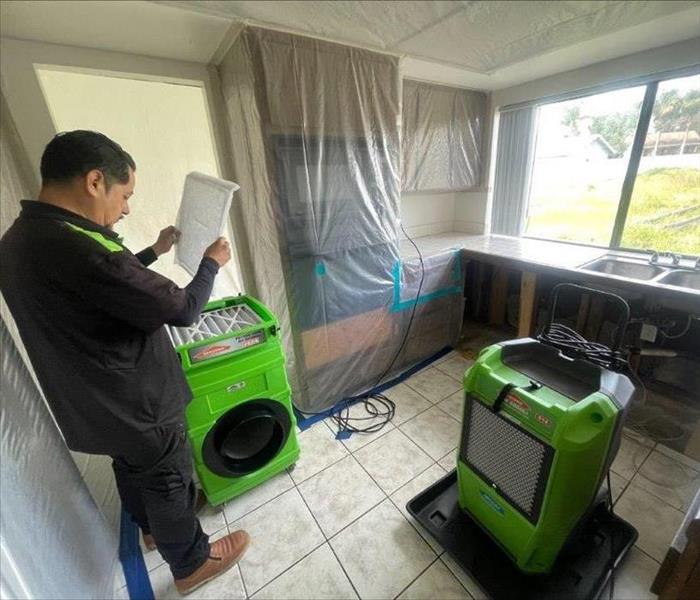 Prompt water damage restoration is crucial for minimizing property damage and preventing mold growth.
Prompt water damage restoration is crucial for minimizing property damage and preventing mold growth.
Water damage can wreak havoc on your property, and the aftermath can be overwhelming. Whether it's from burst pipes, leaky appliances, or natural disasters, the key to minimizing damage is taking swift action. Timely water damage restoration is essential to prevent further deterioration of your property and mitigate potential health hazards.
Understanding the Importance of Timely Restoration
When water damage occurs, it's crucial to address the situation promptly. Delaying restoration efforts can lead to secondary issues such as mold growth, structural damage, and compromised indoor air quality. Mold can begin to develop within 24 to 48 hours after water exposure, posing risks to occupants and worsening property damage. Additionally, prolonged exposure to moisture can weaken building materials and compromise the integrity of your home or business.
Immediate Action Steps
Upon discovering water damage, take immediate action to mitigate further damage. Start by shutting off the main water supply to prevent additional water from entering your property. If safe to do so, unplug electrical appliances and turn off the power supply to avoid electrical hazards. Remove excess water using towels, mops, or wet vacuums, and open windows and doors to facilitate airflow and expedite the drying process.
Contacting Water Damage Restoration Professionals
While DIY cleanup efforts can be tempting, enlisting the expertise of water damage restoration professionals is highly recommended. Experienced technicians have the knowledge, skills, and specialized equipment to assess the extent of the damage and implement effective restoration strategies. They can identify hidden moisture pockets, thoroughly dry affected areas, and sanitize surfaces to prevent mold growth and bacterial contamination.
Comprehensive Assessment and Restoration
Upon arrival, restoration professionals will conduct a comprehensive assessment of the property to determine the best course of action. This may involve extracting standing water, removing damaged materials, and implementing drying techniques such as dehumidification and air circulation. Advanced moisture detection tools, such as infrared cameras and hygrometers, are used to identify moisture infiltration in walls, floors, and ceilings.
Monitoring and Follow-Up
Throughout the restoration process, technicians monitor moisture levels to ensure that affected areas are thoroughly dried and sanitized. Once the restoration is complete, they perform a final inspection to verify that all water damage has been addressed and that the property is safe for occupancy. Additionally, reputable restoration companies provide documentation of the restoration process, including photographs, moisture readings, and itemized invoices, to assist with insurance claims.
Prompt water damage restoration is crucial for minimizing property damage, preventing mold growth, and protecting indoor air quality. By taking immediate action and enlisting the help of qualified professionals, you can mitigate the impact of water damage and restore your property to its preloss condition. Don't delay—contact a trusted water damage restoration company, such as SERVPRO of South Redlands/Yucaipa/North Riverside City at the first sign of water intrusion to ensure a swift and effective restoration process.
10 Signs of Water Damage After a Storm
5/15/2024 (Permalink)
 If you notice any of these signs of water damage after a storm or weather event, it's important to act quickly.
If you notice any of these signs of water damage after a storm or weather event, it's important to act quickly.
After a storm or severe weather event, it's crucial to inspect your property for signs of water damage. Detecting water damage early can prevent further deterioration and costly repairs. Here are some key signs to look out for:
Water Stains
Water stains on walls, ceilings, or floors are telltale signs of water intrusion. These stains may appear discolored, darker, or even moldy, indicating prolonged exposure to moisture.
Musty Odors
A musty or moldy smell in your home, especially in areas prone to moisture, could indicate the presence of hidden water damage. Mold thrives in damp environments and can quickly develop after water intrusion.
Warped or Buckled Flooring
Excess moisture can cause wooden flooring to warp or buckle. If you notice any unevenness or lifting of floorboards, it could be a sign of water damage underneath.
Peeling Paint or Wallpaper
Water seeping into walls can cause paint or wallpaper to peel, bubble, or blister. These cosmetic issues are often indicative of underlying water damage that requires immediate attention.
Sagging Ceilings or Walls
Prolonged exposure to water can weaken the structural integrity of ceilings and walls, causing them to sag or bulge. This is a serious sign of water damage that should be addressed promptly to prevent further structural issues.
Mold Growth
Visible mold growth on walls, ceilings, or other surfaces is a clear indication of water damage. Mold thrives in moist environments and can pose health risks to occupants if left unchecked.
Dampness or Moisture
Feeling dampness or moisture in areas where it shouldn't be, such as carpets, walls, or furniture, suggests water infiltration. Use a moisture meter to detect hidden moisture in building materials.
Water Pooling
Puddles of water or standing water in basements, crawl spaces, or around the foundation of your home indicate poor drainage or water intrusion from outside.
Cracks in Walls or Foundation
Excessive water pressure from heavy rainfall or flooding can cause cracks to form in walls, floors, or the foundation of your home. These cracks allow water to seep in and cause further damage if not addressed promptly.
Increased Utility Bills
A sudden spike in water bills without any corresponding increase in usage could indicate a hidden water leak or other water-related issues within your home.
If you notice any of these signs of water damage after a storm or weather event, it's important to act quickly. Contacting a professional water damage restoration company like SERVPRO® can help mitigate further damage and restore your home to its preloss condition. Don't delay addressing water damage, as prompt action can save you time, money, and stress in the long run.
7 Tips to Keep Your Commercial Kitchen Safe
4/17/2024 (Permalink)
 If you are in need of commercial fire damage cleanup and restoration, don't hesitate and give us a call!
If you are in need of commercial fire damage cleanup and restoration, don't hesitate and give us a call!
In a busy commercial kitchen, safety should always be a top priority. One of the most significant risks in any kitchen environment is the potential for fires, which can result in property damage, business interruption, and even personal injury. To protect your employees, customers, and property, it's essential to implement proactive measures to prevent fires. In this blog post, we'll explore practical tips to help you prevent commercial kitchen fires and maintain a safe working environment.
1. Invest in Quality Equipment
Investing in high-quality kitchen equipment can significantly reduce the risk of fires. Ensure that all appliances, such as stoves, ovens, and deep fryers, are well-maintained and in good working condition. Regularly inspect and service equipment to address any potential issues before they escalate into safety hazards.
2. Practice Proper Ventilation
Adequate ventilation is crucial for removing heat, smoke, and grease from the kitchen environment. Install and maintain exhaust hoods, ductwork, and fans to ensure proper ventilation throughout the kitchen. Regularly clean and inspect ventilation systems to prevent grease buildup, which can pose a fire risk.
3. Train Your Staff
Proper training is key to preventing kitchen fires. Ensure that all kitchen staff receive comprehensive training on fire safety protocols, including how to use fire extinguishers, respond to emergencies, and safely operate kitchen equipment. Regularly conduct fire drills to reinforce safety procedures and ensure that all employees know how to respond in the event of a fire.
4. Maintain a Clean Workspace
A clean and organized kitchen is less likely to experience fires. Implement strict cleaning protocols to keep surfaces, appliances, and exhaust systems free of grease, oil, and other flammable materials. Regularly clean and degrease cooking equipment, countertops, and floors to minimize fire hazards.
5. Monitor Cooking Processes
Keep a close eye on cooking processes at all times to prevent overheating and potential fire hazards. Avoid leaving cooking appliances unattended, and use timers to remind staff to check on food regularly. Train employees to recognize warning signs of potential fire hazards, such as smoke, unusual odors, or excessive heat.
6. Install Fire Suppression Systems
Installing automatic fire suppression systems, such as sprinklers or fire blankets, can provide an additional layer of protection against kitchen fires. These systems can quickly extinguish small fires before they escalate, minimizing damage and preventing injuries.
7. Regular Inspections and Maintenance
Conduct regular inspections and maintenance checks to identify and address potential fire hazards in the kitchen. Inspect electrical systems, gas lines, and cooking equipment for signs of wear or damage, and promptly repair or replace any faulty components.
By implementing these proactive measures, you can significantly reduce the risk of fires in your commercial kitchen and create a safer working environment for your employees. Prioritize fire safety training, maintain proper ventilation and cleanliness, and invest in quality equipment and fire suppression systems to protect your business from the devastating effects of kitchen fires. If a fire does occur, remember to evacuate the premises immediately and contact emergency services for assistance.
A Guide to Removing Mold from Home Insulation
3/12/2024 (Permalink)
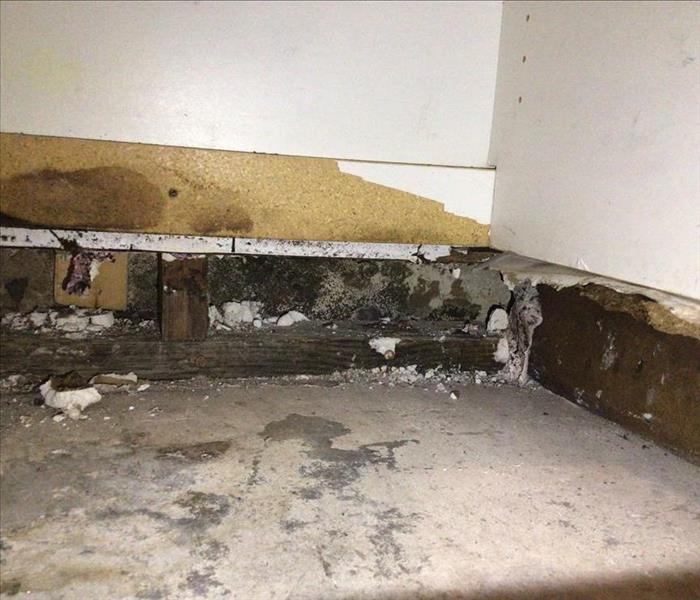 In this blog, we'll provide you with a practical guide on how to effectively remove mold from home insulation without unnecessary fuss.
In this blog, we'll provide you with a practical guide on how to effectively remove mold from home insulation without unnecessary fuss.
Discovering mold in your home insulation can be a cause for concern, but rest assured, addressing the issue is a manageable task. Mold in insulation often occurs in areas with high humidity or water damage, and taking prompt action is crucial. In this blog, we'll provide you with a practical guide on how to effectively remove mold from home insulation without unnecessary fuss.
1. Identify the Affected Area
Begin by identifying the areas of insulation that show signs of mold growth. Look for discoloration, a musty odor, or visible mold patches on the insulation material.
2. Gather Your Supplies
Before diving into the removal process, gather the necessary supplies. You'll need protective gear such as gloves, a mask, and safety glasses. Additionally, have garbage bags, a vacuum cleaner with a HEPA filter, and a stiff brush or sponge ready.
3. Isolate the Area
To prevent the spread of mold spores to other parts of your home, isolate the affected area. Seal off the space with plastic sheeting and tape, creating a containment zone for the removal process.
4. Remove and Discard Moldy Insulation
Carefully remove the mold-affected insulation from the area. Place the insulation directly into garbage bags, sealing them tightly. This ensures that mold spores are contained and don't spread during disposal.
5. Clean the Area
Thoroughly clean the area from which you removed the insulation. Use a stiff brush or sponge along with appropriate cleaning products to scrub the surfaces. This helps remove any remaining mold spores or residues.
6. Vacuum with HEPA Filter
Use a vacuum cleaner equipped with a HEPA filter to carefully vacuum the entire space, including the floor and surrounding surfaces. This helps capture and trap any airborne mold spores, preventing them from spreading.
7. Replace with Mold-Resistant Insulation
After completing the cleaning process, it's time to replace the removed insulation. Consider using mold-resistant insulation materials to minimize the risk of future mold growth. This is particularly important in areas prone to moisture.
8. Address the Source of Moisture
To prevent mold from returning, identify and address the source of moisture. Whether it's a leak, water intrusion, or high humidity, resolving the underlying issue is crucial for long-term mold prevention.
9. Monitor for Recurrence
Keep an eye on the treated area for any signs of mold recurrence. Regular inspections and maintaining a dry environment will help ensure that your efforts in mold removal and prevention are effective.
By following these practical steps, you can successfully remove mold from home insulation and create a healthier indoor environment. Remember, a proactive approach and addressing moisture issues are key to keeping mold at bay.
Danger/Personal Risks Associated with Standing Water in Homes: A Word of Caution
2/4/2024 (Permalink)
Standing water can pose significant risks to both the structure of a home and safety of its occupants. Understanding the potential dangers and personal risks associated with standing water is crucial for homeowners to take immediate action to mitigate these hazards. In this blog post, we will explore the various dangers of standing water in homes and the importance of addressing them promptly.
Electrical Hazards
One of the most dangerous risks associated with standing water is the potential for electrical hazards. When water comes into contact with electrical outlets, appliances, or wiring, it can cause electric shocks, fires, and even electrocution. Homeowners should never enter standing water without first ensuring that the power is shut off to affected areas and should avoid using electrical equipment near water where the power source may not be adequately protected.
Slip and Fall Accidents
Standing water creates a slippery surface, increasing the risk of slip and fall accidents. The wet surfaces can make it challenging to maintain balance, leading to injuries such as sprained ankles, fractured bones, or head trauma. Prompt removal of standing water using appropriate extraction methods should be a priority to eliminate the risk of slip and fall accidents in the home.
Mold Growth and Allergens
Standing water creates a perfect environment for the growth of mold and other allergies. It is essential to address standing water promptly to prevent mold growth and ensure a healthy living environment for everyone in the home. Professional mold remediation may be necessary to thoroughly eliminate mold and prevent its return.
Pest Infestation
Standing water attracts pests, such as mosquitoes, flies, and rodents, that thrive in moist environments. Mosquitoes, in particular, can carry diseases such as West Nile virus or Zika virus. Additionally, rodents seeking water and shelter may enter the home, causing damage to property and spreading diseases. Removing standing water and addressing any entry points or conducive conditions for pests is crucial to prevent infestations and protect the well-being of the household.
Structural Damage
Prolonged exposure to standing water can cause significant structural damage to a home. Water can weaken building materials, such as wood or drywall, leading to rot, warping, and compromised structural integrity. This can result in costly repairs and potentially unsafe living conditions. Timely water extraction, drying, and restoration are essential to prevent further damage to the home's structure.
Standing water in homes presents numerous dangers and personal risks, ranging from electrical hazards and slip and fall accidents to contamination and structural damage. Homeowners should never underestimate the potential risks associated with standing water and must take immediate measures to address the issue through water extraction, drying, disinfection, and professional restoration to safeguard both their property and the well-being of their family.
 A strong foundation is essential for any home or building in California, but foundation cracks and water infiltration can compromise its stability.
A strong foundation is essential for any home or building in California, but foundation cracks and water infiltration can compromise its stability.






 24/7 Emergency Service
24/7 Emergency Service
